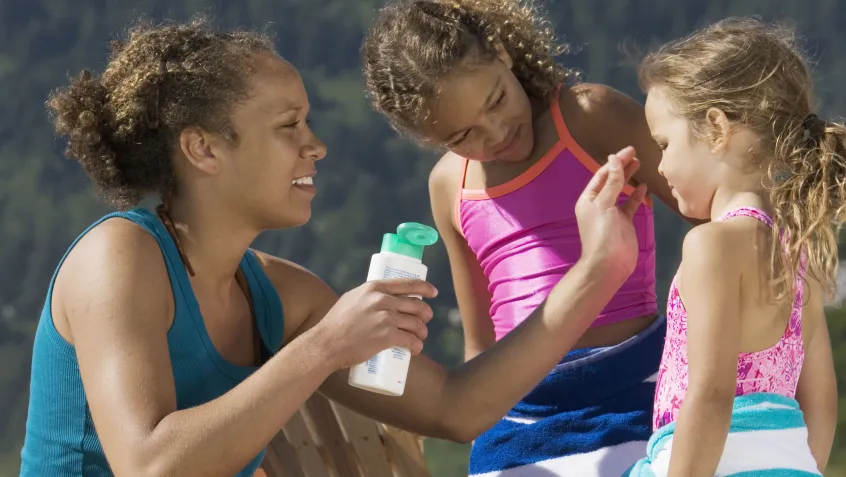
July is UV Safety Month, and with summer in full swing, it’s time for a reminder about staying safe in the sun. Skin cancer is a serious issue in the United States, where each year, more than 3.5 million skin cancers are diagnosed—more than all other forms of cancer combined. While skin cancer can be deadly and is the most common form of cancer diagnosed in the US, it is also highly preventable.
But don’t let this information make you completely avoid the outdoors—getting outside is an important part of a healthy lifestyle, and there are many easy ways you can protect your skin and eyes while enjoying nature.
Read on for frequently asked questions about UV safety to learn how to better protect yourself from the sun. Remember to check the UV Index, combine sun protection strategies, and enjoy the warm summer months!
Is the level of UV protection found in moisturizer and cosmetics that have an SPF as effective as the sun protection afforded by sunscreen?
It depends—when you’re looking for moisturizer or cosmetics to double as sunscreen, there are a few factors you should take into consideration.
- Range of coverage: Look for products that have broad spectrum coverage, with an SPF of at least 15. Broad spectrum sunscreens and the products that contain broad spectrum sunscreen protect you from both UVA and UVB rays. Products that lack the broad spectrum label but still show an SPF factor are only shielding you from UVB rays—thus still leaving you vulnerable. While UVB rays are the ones that primarily cause sunburns and most skin cancers, UVA are also carcinogenic, and are linked to long-term skin damage and may play a role in some skin cancers.
- Frequency of application: For any sunscreen, you should be reapplying it every two hours, as well as after sweating or swimming. If you’re not reapplying your moisturizer or cosmetics that often, you may be leaving yourself unprotected from UV radiation later in the day.
- Amount of product used: You should be using at least one ounce (about two tablespoons, or enough to fill a shot glass) of sunscreen to cover all exposed areas of your body. Most people only apply about 25-50% of this amount, which reduces the product's SPF. You may not be applying this much moisturizer or other cosmetic products—if not, you may want to consider adding a sunscreen to your daily routine.
Finally, even if you are applying the recommended volume of a broad spectrum, 15+ SPF product every two hours, remember that the best way to protect yourself from the sun is to combine sun protection strategies—no one method, including wearing sunscreen, is enough to fully protect you. In addition to using products with broad spectrum SPF, you should still seek shade, wear protective clothing, and put on your sunglasses.
What SPF level is recommended by health organizations?
The SPF unit on a sunscreen product is the “Sun Protection Factor”—this refers to the level of protection that the product provides from UVB rays, which cause sunburns and most skin cancers. The higher levels of SPF mean more protection, but after a certain point the difference in protection levels shrinks.
The Centers for Disease Control and Prevention recommend using a sunscreen with at least 15 SPF, which filters out about 93% of UVB rays. Moving up to 30 SPF, which the American Cancer Society recommends, the sunscreens at that level filter out about 97% of incoming UVB rays. Beyond SPF 30, there is debate about the true effectiveness of these higher-rated products—SPF 50 is designed to filter out about 98% of that radiation, and SPF 100 is designed to absorb 99%, but it’s important to know that no one sunscreen can protect you completely.
Is it possible to get a sunburn if it's cloudy?
Yes! While some types of clouds can partially reduce the amount of UV radiation reaching the surface, other types of clouds can actually reflect that radiation and increase UV exposure on the ground. On the ground, UV rays can then bounce off of surfaces such as water, snow, pavement, and even grass, so be sure to take protective measures no matter what the sky looks like. For a better understanding of your potential UV exposure on a given day, check the UV index, not the clouds.
Should I wait before getting in the water after applying sunscreen?
Yes, no matter what activity you’re about to engage in, you should apply sunscreen 30 minutes before heading outdoors. No product provides instant coverage, so be wary of any packaging that seems to make that claim.
For swimming in particular, look for water resistant sunscreen. No sunscreen is waterproof or sweat proof, and manufacturers are no longer allowed to make that claim on sunscreen packaging. When you’re applying your water resistant sunscreen before heading out to the pool or beach, make sure you check the label carefully—water resistant sunscreen is required to specify whether you should be reapplying the product every 40 or every 80 minutes while swimming or sweating. Sunscreen also usually rubs off when you towel yourself dry, so take that opportunity to reapply the product.
And as always, make sure you combine sun protection strategies:
- Wear sunglasses
- Seek shade
- Wear protective clothing, including a hat with a wide brim
Does sunscreen expire?
Yes. While sunscreens are designed to remain at their original strength for three years, you may need to give them a shake to re-mix the ingredients before applying. However, if the bottle has been exposed to extreme heat for extended periods—for example if it sat in your glove compartment throughout the summer—the shelf life will be reduced as the heat breaks down the active ingredients in the product. Look for an expiration date on the bottle before using the product, and consider using a permanent marker to write the date of purchase on the bottle. When three years have passed since that date—time to get a new bottle!
Will a “base tan” offer protection from further skin damage from the sun?
No. A tan, or a change in your normal skin color as a result of sun exposure, is a sign of skin damage—even if you aren’t turning red as part of a classic sunburn. This “base tan” is a result of injury from UV rays, and at most provides you with a sun protection factor of 3 or less—doing very little to protect you from further UV damage.
Should people of color be concerned about sun safety?
Yes. While people of color have significantly lower incidence rates of melanoma (the most deadly type of skin cancer), UV radiation can still lead to other types of damage for individuals who have higher levels of melanin. The major threats include suppression of the skin’s immune system, which leaves the body vulnerable to other health threats, as well as damage to the eyes.
When discussing UV safety, much of the focus is devoted to the impact of the sun on skin—sun burns, skin cancer, and early signs of aging typically get top bill. However, ultraviolet radiation can also lead to both short and long-term eye damage for people of all ethnicities. According to the American Optometric Association, if your eyes are exposed to high levels of UV radiation over a short amount of time, you may experience what can be described as a type of sunburn on your eyes—also known as photokeratitis—which presents with temporary red eyes, extreme sensitivity to light, and tearing. For long-term overexposure to UV radiation, you have an increased likelihood of developing cataracts or macular degeneration later in life.
To help protect your eyes and the skin that surrounds them, look for sunglasses that block 99-100% of UVA and UVB rays—they may say on the label “UV absorption up to 400 nm” or “Meets ANSI UV Requirements”—this means that the glasses block at least 99% of UV rays. If the glasses only say “cosmetic” on the label, they’re only blocking about 70% of UV ray, and if there is no label, do not assume that the glasses block any UV radiation.
What are some major body parts that are often missed by sunscreen?
Your skin is the largest organ of your body, so it can be easy to miss a spot with your sun protection coverage. When applying your sunscreen, cover any skin that is going to be exposed. Some common areas that may be missed include:
- Face
- Ears
- Neck
- Backs of the hands
- Lips (look for lip balms or lipstick with broad spectrum SPF of at least 15)
- Scalp
- Tops of feet
- Nose
What should be done if I'm worried I have skin damage from the sun?
If you’re concerned that you may have some skin damage or irregularity as a result of UV exposure, you can take steps at home to monitor your health, and you can speak to your physician. Your doctor may recommend that you check your skin yourself about once a month so you can catch any irregularities early.
To perform a home skin check, follow these steps from the American Cancer Society. For more guidance, refer to this skin self-exam infographic from ACS.
Sources:
- American Cancer Society. 2015. “Skin Cancer Facts.” Accessed July 19, 2016. http://www.cancer.org/cancer/cancercauses/sunanduvexposure/skin-cancer-facts.
- American Cancer Society. 2015. “Skin Cancer Prevention and Early Detection: How do I Protect Myself from UV Rays?” Accessed July 19, 2016. http://www.cancer.org/cancer/cancercauses/sunanduvexposure/skincancerpreventionandearlydetection/skin-cancer-prevention-and-early-detection-u-v-protection.
- American Cancer Society. 2015. “Skin Cancer Prevention and Early Detection: What is Ultraviolet (UV) Radiation?” Accessed July 19, 2016. http://www.cancer.org/cancer/skincancer-melanoma/moreinformation/skincancerpreventionandearlydetection/skin-cancer-prevention-and-early-detection-what-is-u-v-radiation.
- American Cancer Society. 2016. “American Cancer Society Skin Cancer Prevention Activities.” Accessed July 19. http://www.cancer.org/healthy/morewaysacshelpsyoustaywell/acs-skin-cancer-prevention-activities.
- American Cancer Society. 2016. “Don’t Fry: Preventing Skin Cancer.” Accessed July 19. http://www.cancer.org/research/infographicgallery/skin-cancer-prevention#U10Zx61xtjbfjcbJ.97.
- American Cancer Society. 2016. “Protect Your Skin from the Sun.” Accessed July 19. http://www.cancer.org/cancer/news/features/stay-sun-safe-this-summer.
- American Optometric Association. 2016. “UV Protection: Protecting Your Eyes from Solar Radiation.” Accessed July 19. http://www.aoa.org/patients-and-public/caring-for-your-vision/uv-protection?sso=y.
- Ansdell, Vernon E., and Amy K. Reisenauer. 2016. “Chapter 2: The Pre-Travel Consultation; Sun Exposure.” In CDC Health Information for International Travel 2016. CDC, US DHHS. http://wwwnc.cdc.gov/travel/yellowbook/2016/the-pre-travel-consultation/sun-exposure.
- Calvo, Trisha. 2014. “Does Sunscreen Ever Expire?” Consumer Reports, May 24. http://www.consumerreports.org/cro/news/2014/05/does-sunscreen-expire/index.htm.
- CDC. 2013. “Traveler’s Health: Sun Exposure.” US DHHS. Accessed July 18, 2016. http://wwwnc.cdc.gov/travel/page/sun-exposure.
- CDC. 2014. “Skin Cancer: The Burning Truth; A Base Tan is Not a Safe Tan.” US DHHS. Accessed July 19, 2016. http://www.cdc.gov/cancer/skin/burningtruth/base_tan_not_safe_tan.htm.
- CDC. 2016. “Skin Cancer: How Can I Protect My Children from the Sun?” US DHHS. Accessed July 18. http://www.cdc.gov/cancer/skin/basic_info/children.htm.
- National Council on Skin Cancer Prevention. 2016. “Don’t Fry Day.” Accessed July 19. http://www.skincancerprevention.org/programs/dont-fry-day.
- Office of Air and Radiation. 2013. “Prevent Eye Damage: Protect Yourself from UV Radiation.” EPA 430-F-13-023. US EPA. https://www.epa.gov/sites/production/files/2015-11/documents/epa_sw_fs_eyedamage_v7_508_release_0.pdf.

